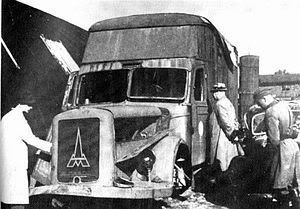Two Brits in OZ thanks to Richard Mohr.
oily
That Iveco of PDM’s looks close if not over its front axle weight I realise it has the crane but even at that it has the look of a motor that could well attract the attention of Vosa. Eddie.
oiltreader:
A nicely preserved Dodge.
oily
Nice one there oily, what a credit to it’s owner. ![]()
These pictures are from grobertson4 and within the terms of creative commons licence. During our flickrmail exchange he has also kindly allowed me to post photos from his all rights reserved collection, some nice old motors.
oily
A couple of A Walker & Sons.
oily






crow carrying co depots in the 20s 50s and 80s. any one got any pics on cow carrying co can you please send them to me regards clint york
yorkie007:
crow carrying co depots in the 20s 50s and 80s. any one got any pics on cow carrying co can you please send them to me regards clint york
Hi yorkie007
I have some somewhere (from an old magazine) which I may have posted a while ago, had a dig today, can’t find them, off for a few days tomorrow, will have another look when I get back.
oily
harry:
Some interesting Maggie factoids.
Gestapo truck of choice.
The gas van or gas wagon (German: Gaswagen; Russian: душегубка; Serbian: душегупка) was an extermination method devised by ■■■■ Germany to kill victims of the regime.[1] It was also rumored that an analog of such a device was used by the Soviet Union on an experimental basis during the Great Purge.[2][3][4][5][6]
During trips to Russia in 1941, Heinrich Himmler learned the psychological impact on the Einsatzgruppen killers posed by the shooting of women and children. Hence, he commissioned Arthur Nebe to explore ways of killing that were less stressful for the killers. Nebe’s experiments eventually led to the production of the gas van.[7] This vehicle had already been used in 1940 for the gassing of East Prussian Pomeranian mental patients in Soldau, a camp located in the former Polish corridor.[8] On application by the Nazis gazvagenov became known in 1943 after the trial of members of crimes against humanity committed in the territory of the Krasnodar Territory of the USSR, where about 7,000 civilians were killed by gas poisoning. It was a vehicle with an airtight compartment for victims, into which exhaust gas was piped while the engine was running. As a result, the victims were gassed with carbon monoxide, resulting in death by the combined effects of carbon monoxide poisoning and suffocation. The suffocations usually occurred as the gas van was carrying the victims to a freshly dug pit or ravine for mass burial.
Gas vans were used, particularly at CheÅ‚mno extermination camp, until gas chambers were developed as a more efficient method for killing large numbers of people. In Belgrade, the gas van was known as “DuÅ¡egupka” and in the occupied parts of the USSR similarly as “душегубка” (dushegubka, literally (feminine) soul killer/exterminator).
The use of gas vans had two disadvantages:
1.It was slow–some victims took twenty minutes to die.
2.It was not quiet–The drivers could hear the victims’ screams, which they found distracting and disturbing.
By June 1942 the main producer of gas vans, Gaubschat Fahrzeugwerke GmbH, delivered 20 gas vans in 2 models (for 30-50 and 70-100 individuals) to Einsatzgruppen, out of 30 ordered. Not one gas van was extant at the end of the war. The existence of gas vans first came to light in 1943 during the trial of ■■■■ collaborators involved in the gassing of 6700 civilians in Krasnodar. The total number of gas van gassings is unknown. One German document dated June 5, 1942 in occupied Minsk indicates that from December 1941 to June 1942 3 gas vans were used to kill 97,000 civilians.The gas vans are extensively discussed in some of the interviews in Claude Lanzmann’s film, Shoah.
Now you know why I loathe Maggies.
Gaubschat Fahrzeugwerke GmbH
This is on Who do you think you are with Jerry Springer
Interesting stuff wheel nut.
Big coincidence. I’ve just visited the museum of the resistance in Besancon. Very harrowing and very explicit photos of ■■■■ atrocities and executions and torture. Not for the faint hearted.
You may get some criticism for posting this but these trucks were used and all of us should remember the huge debt we owe to our forebears for standing up to ■■■■ brutality. In particular the resistance fighters in the occupied countries were very very brave men and most of them met a terrible grisly end in the fight for freedom. A lot of them were Truck drivers like us. I for one salute them!
They gave their tomorrows so we could live in peace and freedom today.
daibootsy:
I.S.C, Swansea.
Nice one daibootsy.
oily





































